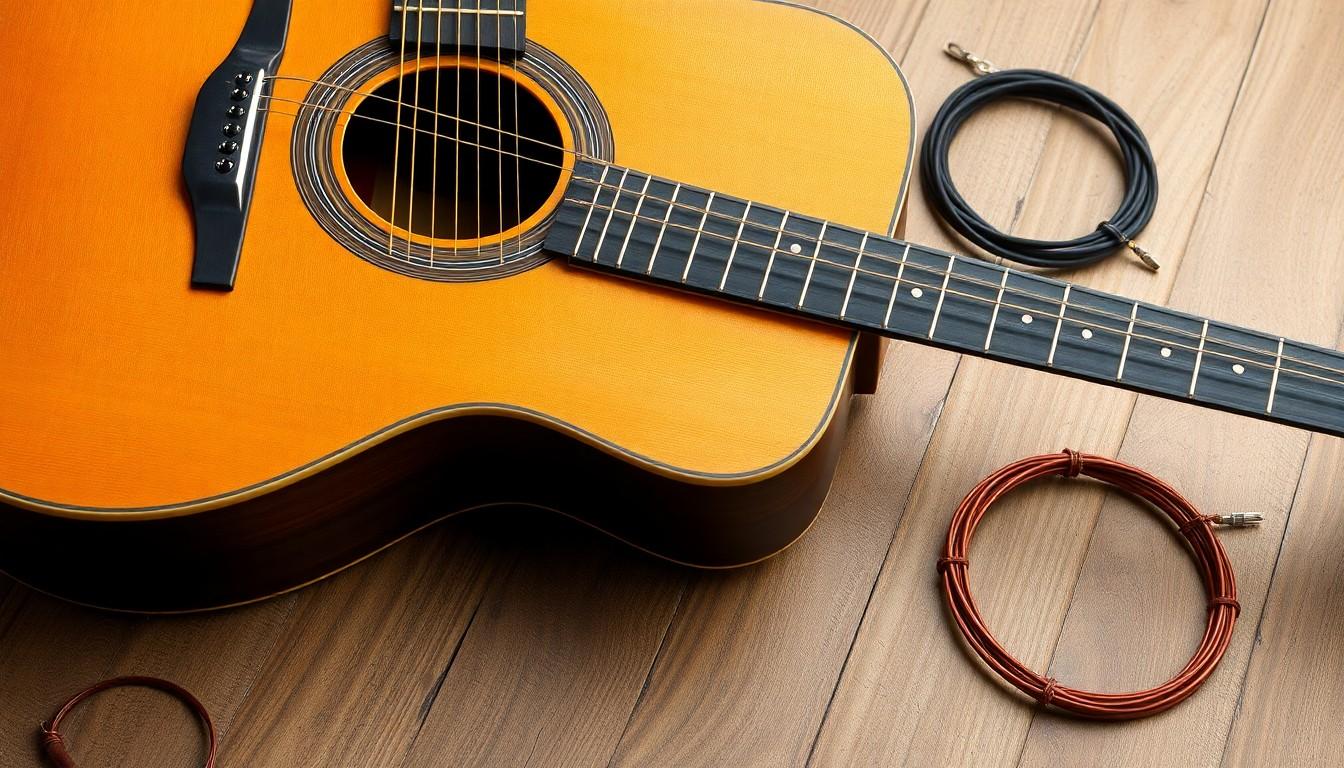Ever found yourself tangled in a mess of guitar strings, wondering which one goes where? Understanding the guitar strings in order is the key to unlocking a harmonious playing experience. It’s not just about tightening and plucking – the right sequence can make your tunes sing.
From the deep resonance of the low E to the bright chirp of the high E, each string has its unique role. Getting them in order ensures your riffs flow smoothly and your chords sound crisp. Whether you’re a beginner strumming your first chords or a seasoned pro fine-tuning your setup, mastering the order of guitar strings is essential for every guitarist.
Guitar Strings in Order
Grasping the order of guitar strings is essential for playing accurately. It ensures each note sounds as intended.
Standard Tuning
Standard tuning arranges guitar strings in the sequence E, A, D, G, B, E. The lowest string is the thickest, producing deeper sounds. Each string corresponds to a specific pitch: E2, A2, D3, G3, B3, and E4. Musicians rely on this tuning for consistent chord shapes and melodies. Maintaining standard tuning allows easy collaboration with other players. Deviating from this setup requires relearning finger positions and chord formations. Tuning each string correctly supports harmonious playing and minimizes dissonance in performances.
String Numbering
String numbering identifies each string’s position on the guitar. Typically, the sixth string is the lowest E, followed by fifth A, fourth D, third G, second B, and first high E. Numbering starts from the thickest string as six to the thinnest as one. This system assists in reading guitar tablature and sheet music accurately. Players reference string numbers when discussing techniques and finger placements. Understanding string numbering streamlines communication between guitarists. It also facilitates learning scales and arpeggios by providing clear positional guidance.
Types of Guitar Strings

Guitar strings come in various types, each suited to different playing styles and instruments. Understanding the differences helps musicians choose the right strings for their needs.
Acoustic Strings
Acoustic strings typically feature a steel or bronze core wrapped with materials like phosphor bronze or silk and steel. They produce rich, resonant tones essential for unplugged performances. The gauge of acoustic strings ranges from light (0.010) to heavy (0.014), affecting both volume and playability. For example, a 0.012 gauge offers a balanced sound, making it a popular choice among folk and country players. Coated acoustic strings provide extended lifespan by resisting corrosion from sweat and humidity. Additionally, some acoustic strings incorporate nylon cores for a softer feel. Manufacturers like D’Addario and Martin offer a variety of acoustic strings tailored to different tonal preferences. Choosing the appropriate acoustic strings enhances the guitar’s natural sound, ensuring clarity in chords and melodies.
Electric Strings
Electric strings are designed to work with amplified instruments, focusing on clarity and sustain. They usually consist of nickel-plated steel or pure nickel cores, wrapped with materials such as stainless steel or nickel. String gauges for electric guitars range from extra light (0.008) to heavy (0.011), impacting tone and ease of bending. For instance, a 0.009 gauge provides a bright sound and smooth playability, favored by rock and blues guitarists. Flatwound electric strings offer a smoother surface, reducing finger noise and enhancing sustain, ideal for jazz players. Conversely, roundwound strings deliver a brighter, more aggressive tone suitable for genres like metal and pop. Brands like Ernie Ball and Fender supply electric strings with diverse characteristics, enabling players to achieve their desired sound. Selecting the right electric strings is crucial for optimal performance and tonal versatility.
Installing Guitar Strings in Order
Proper installation ensures optimal performance and longevity of guitar strings. Follow these steps to replace your strings efficiently.
Tools Needed
- String Winder: Speeds up the winding process.
- Tuner: Ensures accurate pitch for each string.
- Wire Cutters: Trims excess string length.
- String Cleaner: Removes residue from the fretboard.
- Phillips Screwdriver: Adjusts bridge and tuning pegs if necessary.
Step-by-Step Process
- Remove Old Strings: Loosen each string using the tuning pegs, then carefully unwind and discard them.
- Clean the Guitar: Wipe the fretboard and body to eliminate dirt and oils.
- Attach New Strings: Starting with the low E, thread each string through the bridge and secure it to the tuning peg.
- Wind the Strings: Use the string winder to tighten each string, ensuring even coils around the peg.
- Cut Excess Length: Trim any surplus string beyond the peg for a clean finish.
- Tune the Guitar: Use the tuner to adjust each string to its standard pitch, verifying correct installation.
Choosing the Right Strings
Selecting the right guitar strings enhances both tone and playability. Different materials and gauges cater to various musical styles and preferences.
Material Options
Guitar strings come in multiple materials, each influencing sound and durability. For electric guitars, nickel-plated steel offers a bright, balanced tone favored in rock and pop genres. Stainless steel strings provide increased durability and a sharper sound, ideal for metal and heavy styles. Coated strings, such as those with polymer layers, resist corrosion and extend longevity, making them suitable for frequent performers. Acoustic strings typically use bronze or phosphor bronze cores, delivering rich and resonant tones perfect for unplugged settings. Silk and steel strings incorporate silk fibers, offering a softer feel and mellow sound, popular in jazz and fingerstyle playing. Nylon strings, used in classical guitars, produce warm and smooth tones suitable for classical and flamenco music. Choosing the appropriate material aligns with a guitarist’s genre and desired tonal characteristics, ensuring optimal performance across various musical contexts.
Gauge Selection
String gauge significantly affects a guitar’s playability and tone. Lighter gauges, such as .009 to .042, enable easier bending and faster fretting, ideal for beginners and lead guitarists seeking agility. Heavier gauges, like .011 to .052, offer increased volume and sustain, preferred in rhythm playing and genres requiring robust sound. Medium gauges, ranging from .010 to .046, provide a balance between playability and tonal richness, suitable for diverse styles. Additionally, gauge impacts string tension; lighter strings reduce neck strain, while heavier strings demand stronger neck support. Guitarists often experiment with different gauges to achieve the optimal feel for their technique and musical genre. Proper gauge selection ensures a harmonious blend of comfort and sound quality, enhancing the overall playing experience.
Maintaining Your Guitar Strings
Regular maintenance extends the lifespan and enhances the performance of guitar strings. Cleaning strings after each session removes oils and dirt, preserving their brightness. Use a microfiber cloth to wipe down each string gently. Conditioning wipes can also reduce corrosion, maintaining smooth playability.
Proper storage prevents string degradation. Keep the guitar in a controlled environment, avoiding extreme temperatures and humidity. Use a case or a guitar stand with protection to minimize exposure to harmful elements. Additionally, storing the instrument away from direct sunlight preserves string integrity.
Routine inspections identify wear and tear early. Examine each string for signs of rust, fraying, or loss of elasticity. Replace strings showing significant damage to maintain optimal sound quality. Monitoring string condition ensures consistent performance and reduces the risk of unexpected breaks during play.
Changing strings at regular intervals maintains tonal clarity. Frequency depends on playing intensity, typically every four to eight weeks for active players. Fresh strings provide better sustain and responsiveness, enhancing overall musical expression. Scheduling timely replacements supports sustained performance quality.
Lubricating the nut and bridge minimizes friction, extending string life. Apply a small amount of graphite or specialty lubricant to these areas regularly. Reduced friction prevents binding and uneven wear, ensuring smooth tuning and bending. Proper lubrication contributes to a stable and reliable playing experience.
Adhering to these maintenance practices ensures guitar strings remain in excellent condition. Consistent care maximizes their performance, supporting musicians in achieving their desired sound.
experience
Understanding the order of guitar strings is key to unlocking the instrument’s full potential. Proper tuning and selecting the right strings can significantly enhance sound and playing technique. Ensuring strings are correctly installed and regularly maintained not only extends their lifespan but also guarantees consistent performance. By appreciating each string’s unique role and taking care of them diligently, guitarists can achieve smoother riffs, crisper chords, and an overall enhanced playing experience. Embracing these practices lays a solid foundation for creating impactful and memorable music.

